by BaboonyTim
In this post, I’m going to lay out my thoughts about what I think the best decks in Redemption in 2024 are and what the power-level of your deck needs to be at in order to be competitive in tournaments. *Disclaimer: this article specifically applies to T1 2P, and is not focused on Type 2, Draft, or Sealed.
But first, I’d like to lay out some basic premises which I believe hold true about Redemption in 2024. Once we accept the premises, then we can talk about the best decks in Redemption. Here are the list of reasons why I believe T1 2P Redemption in 2024 favors offense over defense:
- Tournament Scoring doesn’t favor defensive decks
- Offenses can “shoot first” with their Dominants
- Offenses (typically) have more resources to work with
- Offenses (typically) have more characters in battle than the defense
- Good battle dominants enable banding offenses to bypass traditional counters
- Having a consistent way to generate card advantage is very important to winning
Redemption is a game where the attacker generally gets to dictate the terms of the engagement. The offense makes the first move, triggers its effect first, and generally gets to make the most optimal choice when faced with an idea of what the opponent’s strategy is. The opponent’s defense then has to react to what the opponent is doing, and their reactions can be pretty limited due to the restrictions the attacker can place upon them.
There are exceptions, but generally speaking heroes have better effects than evil characters. Good Dominants are more powerful than Evil Dominants. Good fortresses are better than evil fortresses. And its easier to make a successful rescue than a successful block. Redemption rewards players for playing offensively and punishes players trying to play a more defensive game. Allow me to explain:
1) Tournament Scoring doesn’t favor defensive decks
A deck heavily slanted towards defense deck might have a great time of blocking, but as a result of how long games of Redemption take to play, there’s a high chance that they won’t be able to rescue 5 lost souls needed to get a full win since you are dedicating more resources to your defense at the expense of your offensive speed and punching power. Rounds are only 45 minutes long.
In Redemption tournaments, a full win (getting to 5 lost souls) is scored as 3 round points. Getting a partial win (having more lost souls than the opponent but NOT getting to 5 lost souls before time is called) is scored as 2 points. So lets say you had two different people playing at the same 8 round tournament. One was playing a deck that could get full wins 50% of the time. The other was playing a defensive deck that could win 75% percent of the time but they were all only partial wins. Over the course of an 8 round tournament, who do you think would fare better?
Player A (Balanced, 50% full wins): 4 full wins (4 x 3 points = 12 points)
Player B (Defensive, 75% partial wins) 6 partial wins (2 x 6 points = 12 points)
Turns out that despite having a 75% “win” rate and winning 2 more games than the balanced player, both players would actually end up scoring the same number of points. You would have to find an impressively powerful strategy or find a way to play very quickly (which often times the pace of the game lies in factors outside your control, like the pace your opponent plays at) in order for you to logically consider approaching competitive Redemption trying to play a strong defense.
As another side note, Redemption tournaments also prioritize keeping track of soul differential (the differences of souls between what you’ve rescued and what your opponent has rescued). Defensive decks that are looking to edge out narrow victories via incremental advantages aren’t going to be as rewarded as fast Redemption decks looking to steamroll the opponents by creating fast, large advantages.
In addition to the pure theoretical logic about defensive decks in a tournament, let’s take a look at some scenarios about why offenses seem to have a better time of blitzing through defenses.
2) Offenses can “shoot first” with their Dominants
In a gunfight, it often comes down to who can get their shot off first (citation: see Han Solo vs Greedo). In Redemption, the active player (the attacker) is the one who gets the first chance to play their Dominants. This inherently creates an advantage for the attacker.
Defender has a Christian Martyr? They are going to have to wait to play it until the opponent has played The Resurrection to band in 3 more heroes to battle (by that point its too late). Defender has a Grapes of Wrath to shuffle the attack away? They will have to wait until the attack has played Angel of the Lord on their lone defensive character (and by that point it will be too late).
3) Offenses (typically) have more resources to work with
Offenses will typically have access to more resources than the defender. At the start of the turn, the attacker is the one who draws 3 cards. They also have the opportunity to get more offensive firepower from artifacts, fortresses, and territory class enhancements. Not to mention that when their heroes enter battle and trigger their abilities first, those heroes can also generate even more offensive resources. Its not unreasonable to think that before blocks are declared, the offense will be up 4-5 cards on average than the defense (and that’s being modest in my opinion).
In addition to gaining cards due to the nature of being the active player, offenses can preemptively take away or destroy resources used by the defense before the defense has a chance to respond. Cards like Twenty Shekels + Mary, Holy Virgin, Jephtha, First Sacrifice, Teaching in Parables, and Promised Land can put the defender at immediate disadvantages with little counter-play.

What can offenses do with this resource advantage? Well one of the things they can do is put more characters into battle, which leads to my next point.
4.a) Offenses (typically) have more characters in battle than the defense
In my experience, lots of offenses in Redemption use large banding chains to attack the opponent. Because of the prevalence of heroes that band and how easy it is to attack with two or more of these heroes, defenses are outnumbered in battle. This puts pressure on the defense to have an answer each turn to the attack because the attackers numbers will be larger than the defense. They can’t just block and put the pressure on the offense to get past them. When’s the last time an Emperor Nero could block and threaten to stonewall the opponent? (Side note, this is why I like Goliath, Herod the Great, Emperor Claudius, and Herod Agrippa I so much, especially when backed up by Herod’s temple because they break this paradigm and force the opponents to have an answer to them, not the other way around)
In most scenarios I’ve experienced in modern Redemption, it will be 2 or more heroes in battle vs 1 evil character. And in situations like this Angel of the Lord is a lot stronger than Christian Martyr. Most of the time, the onus to win the battle is placed on the defender.
4.b) Good battle dominants enable banding offenses to bypass traditional counters
Defenses do have great ways to punish lots of heroes being banded into battle, but these “outs” are being nullified by the offensive dominants seeing play.
Cards like Unsuccessful, Futile Inquisition, Contagious Fear, Abandonment, No Straw, Scattered, and Scattered Sheep are the cards meant to keep these types of banding chains at bay.
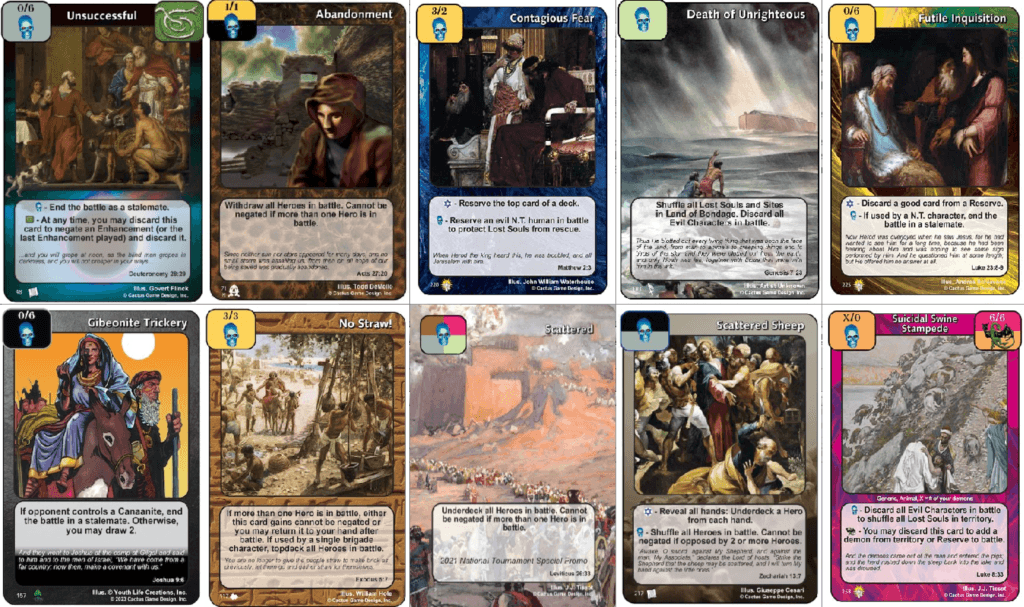
But do these cards even matter? The offense can play at least 3 of these:
- Glory of the Lord (restricting those enhancements)
- Angel of the Lord (killing the evil character blocking before they can play those enhancements)
- Ride On (which allows the offense to play their battle winner before the defense)
- The Resurrection (to band in John, the Fisherman which can toss the evil battle winner)
- Star of Bethlehem + Flight into Egypt to protect the banding chain from harm
- Buckler to grant protection
- The Long Day to grant insurance
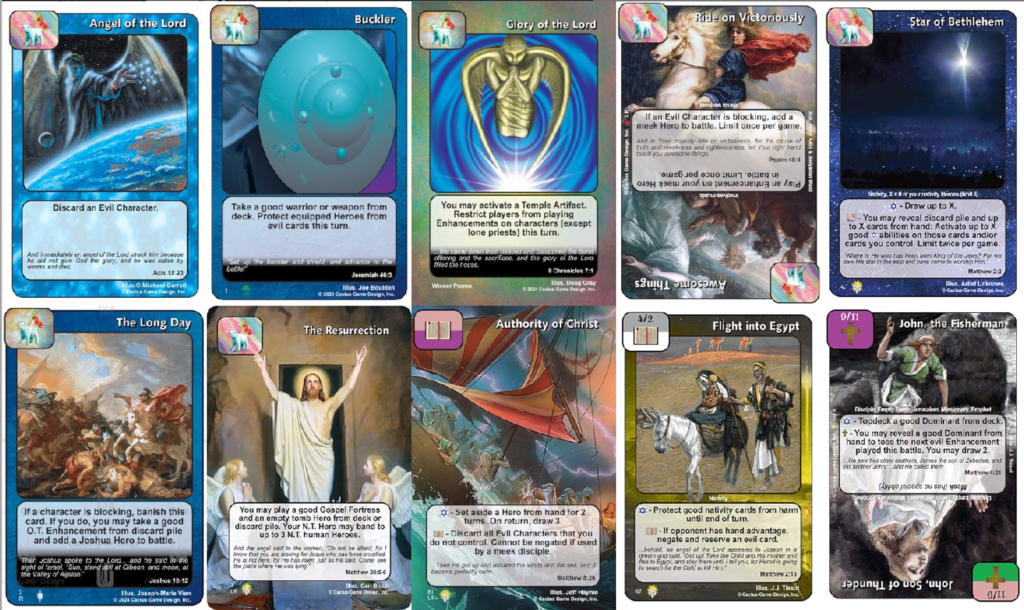
And that’s just the dominants. Cards like Coliseum, Goshen, and The Cross can also make Scattered enhancements useless:

With the printing of Glory of the Lord, I believe we have reached the point where decks can run a critical density of quality battle dominants to let them attack with large banding chains each turn without fear of punishment. Glory of the Lord and Star of Bethlehem are the biggest parts about why I’ve found so much success with Nativity. Add Angel of the Lord into the Nativity deck and you have a strategy even less concerned about traditional counters to banding chains. The reason the deck doesn’t play Angel of the Lord is that it would be overkill.
I will add a postnote to this section that the printing of some cards in Israel’s Inheritance might help defenses block these types of attacks more consistently (Woman of Thebez and “Subdued” Lost Soul) but its too early to tell if its enough to tip the tide. My gut feeling says its not enough and that offenses have tools to beat both of these cards)
Having a consistent way to generate card advantage is very important to winning
If the best types of offenses are ones that can push multiple heroes into battle and protect them with their battle dominants, then it becomes important to consistently draw enough cards to get the critical mass of heroes and dominants needed to push through each turn.
The more cards you have access to before the defender can declare a block, the better your odds are at getting through successfully. That’s why its important to accumulate resources proactively and consistently.
Here is my primitive tier of ways to generate card advantage that tries to explain what I’m talking about when I say “consistent” vs “inconsistent” and “proactive” vs “reactive.”
S tier: consistent unnegateable card draw (dominants that draw cards, Matthew, Zechariah the silent)
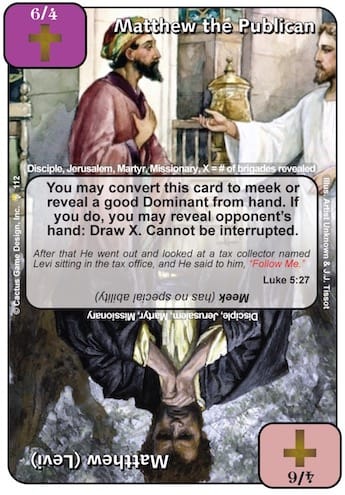
A tier: consistent proactive card draw (Four-Drachma Coin, Denarius, John, the Fisherman)
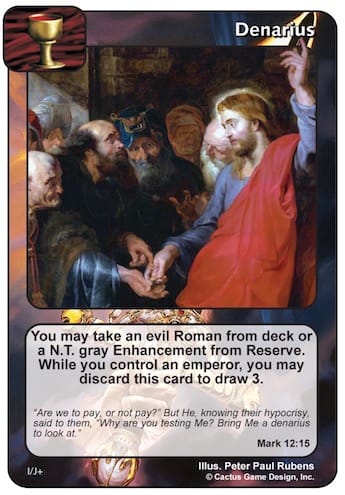
B tier: consistent reactive card draw (The Herdsmen of Gerar, Lying Prophet)
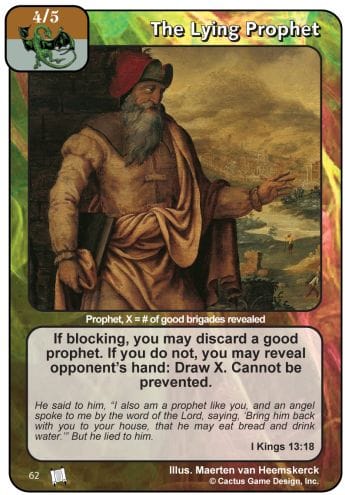
C tier: inconsistent card draw on proactive good enhancements (Reach of Desperation, Generous Giving)
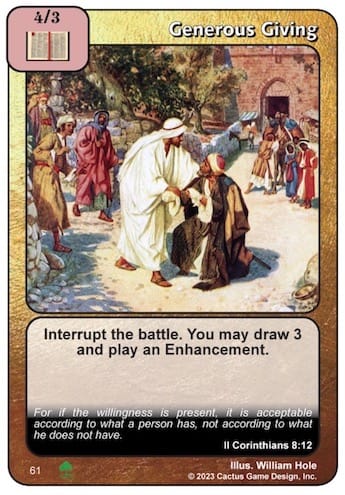
D tier: inconsistent card draw on reactive evil enhancements (Mask of Vanity, Betrayal)
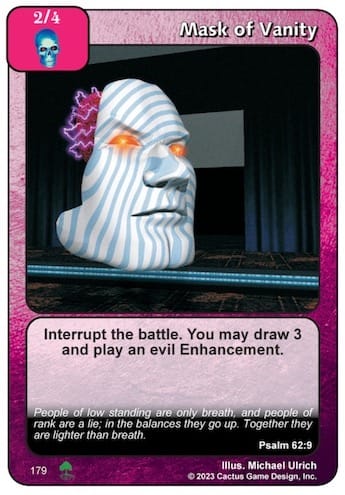
Explanation: Cards like Matthew and Zechariah, the Silent are the best forms of card advantage because they are easy to trigger and can’t be negated. Cards you leverage from them can immediately be used in battle. Cards that are reactive like Herdsmen or Lying Prophet can be situationally good, but inherently worse than proactive forms of card advantage in my book). The worse form of card advantage is the inconsistent card draw you get on enhancements. Good enhancements are easier to play in battle than evil ones, and good enhancements get a higher tier because you can immediately play your offensive dominants in battle after you finish the enhancement.
Bonus section: cards like First Sacrifice and Teaching in parables aren’t card advantage per se, but I would give them great weight because of how proactive they are. You get to see what the opponents are up to and take away their best defensive resources. Taking a 1-for-1 card trade when you are inherently ahead on resources is going to cripple most defenses.
The Best Decks in Redemption:
So, if you’ve accepted my premises thus far, we are on the same page about how defenses are on the back-foot, offensive dominants + banding are the best way to attack defenses, and proactively drawing cards is the best way to get your offense online.
Then it follows that the best decks in Redemption are ones that are built to rescue 5 lost souls within 45 minutes, play at least 2 battle dominants, can consistently and proactively generate card advantage (preferably by banding lots of heroes into battle)
Clay Matthew decks, Nativity decks, and Joshua decks are types of decks that can do all of these things. These decks get my vote for the best decks in Redemption right now.
Joemama’s Clay deck (Nationals 2024: top 8)

Clay decks have access to Matthew to generate lots of cards and can play lots of different battle dominants. Joemama’s deck from Nationals is packed to the brim with them! This deck relies heavily on Matthew, so it could struggle against decks protecting their hand or playing lower number of brigades. It also doesn’t play a lot of banding so it could also be stopped by Christian Martyr. (Pro tip: I’d swap out Betrayal and put in Generous Giving as a small improvement for helping the deck’s card draw consistency)
AgurTheWise Nativity (Nationals 2024: 2nd place)

Nativity is a touch slower than Clay decks, but its power level is still just as high. Chaining back to back Star of Bethlehems + Flight into Egypt is backbreaking against most defenses. The deck can draw an absurd number of cards and was strong enough to place both 1st AND 2nd place at Nationals. It can be very dependent on its fortresses to setup its best attacks, so Joshua decks might be able to play “foil” to Nativity as a strategy.
You can buy this deck from YTG games here at a discounted price!
Bingaling’s Joshua: (decklist here)
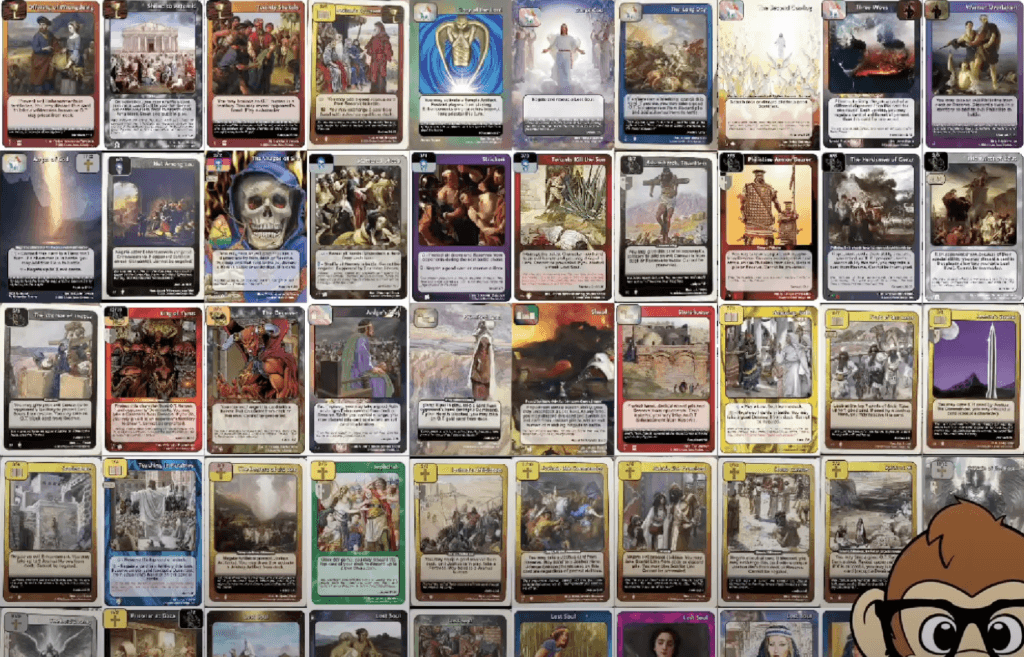
The newest kid on the block, Joshua appears to have everything it needs to be a deck that can plow through people and draw a bunch of cards. They have access to a great suite of battle dominants (I think Angel of the Lord is better than Angel of God, for the record) and thanks to Captain of the Host can draw lots of cards. I think the deck is a bit less consistent than Nativity or Joshua, but this deck has a lot of potential to become an S tier deck in my opinion. It has all the ingredients, and it will be up to the chefs to see if this can cook with the proven decks.
Conclusion
These are the best types of decks and if you aren’t playing a strategy that can keep up with them or counter them you are going to have a hard time of taking down tournaments!
Thanks for reading! I appreciate you taking the time to hear my thoughts. And as always, you are free to disagree with any or all the points I have made! Signing off for now
–BaboonyTim
Postscript: countering the meta
TheGuardian, if you are reading this, I think you understand Redemption at a deep level. Your GoldenEye deck has a happy place in my heart and I think its my favorite deck I’ve seen as far as its strategy, creativity, and innovation of playing d-heavy in the face of the offensive onslaught. This deck has a plan against decks that draw lots of cards and plays enough defensive battle dominants to ensure that the cards that punish banding be played.
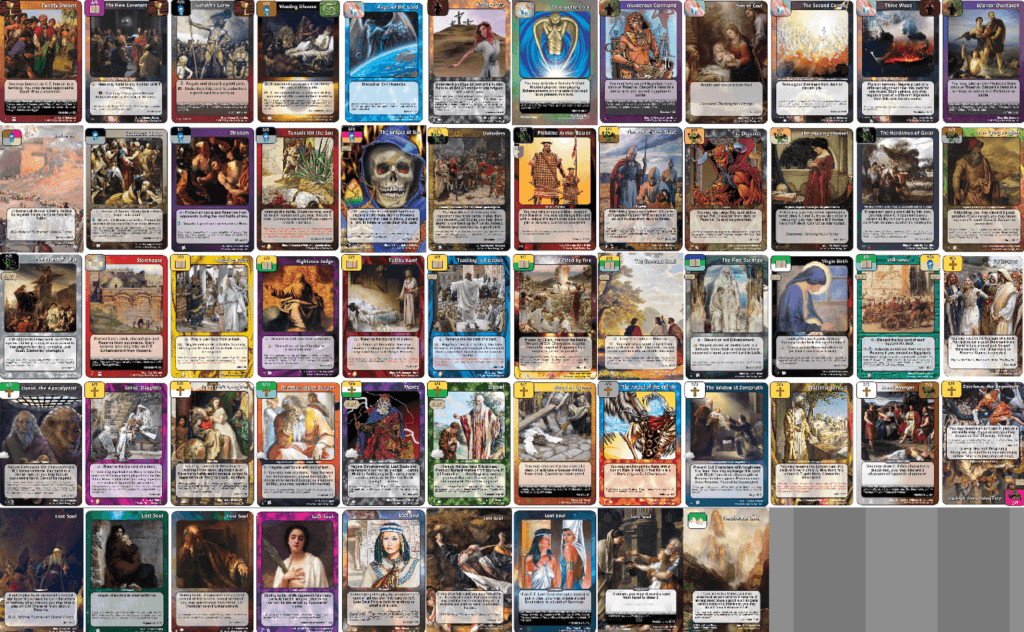
GoldenEye deck tech can be watched here:
To buy singles, sealed product, and other gaming supplies mentioned, please visit our sponsors!
